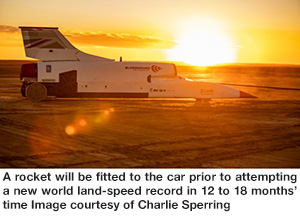Bloodhound LSR – back on the road to making history
14/02/2020
The Bloodhound Land Speed Record (LSR) team is in a celebratory mood, having successfully completed the crucial high-speed testing phase of the programme, during which it notched eye-watering speeds of 628 mph (1010 km/h). This places the Bloodhound LSR car, unofficially, as the sixth fastest car of all time. The tests took place on the Hakskeen Pan, a dry lake bed in the Kalahari Desert in South Africa. The alkali playa is some 20 km long and, to conduct the tests, a 500 m × 16 km strip was cleared of stones and had 20 straight lines painted along its length, creating the desert ‘racetrack’ on which the Bloodhound LSR car was put through its paces.
The tests took place on the Hakskeen Pan, a dry lake bed in the Kalahari Desert in South Africa. The alkali playa is some 20 km long and, to conduct the tests, a 500 m × 16 km strip was cleared of stones and had 20 straight lines painted along its length, creating the desert ‘racetrack’ on which the Bloodhound LSR car was put through its paces.Driven by Andy Green, the Bloodhound LSR car reached a maximum speed of 628 mph (1010 km/h) from a standing start in 50 s. Going fast was not, however, the primary aim. The 12 run profiles were designed to develop the team, hone operational processes, deliver crucial data and prepare the car for the record attempt within the next 18 months.
Ian Warhurst, owner of Bloodhound LSR, said: “The global media interest around the high-speed testing has really raised our profile and potential sponsors are getting in touch every day. Our partners will have opportunities to get involved in the next exciting phase of the project, as we develop the monopropellant rocket and prepare the car for supersonic speeds.
“With the data we have generated from the high-speed testing we are able to start budgeting for the next phase of the project, which will need to be funded through sponsorship. We know it will require up to £10 million and the incredible social engagement with our high-speed testing programme has proven that sponsors will see a return on investment and be a part of history.”
Recording data was a high-tech process. The Bloodhound LSR car is covered with 192 air pressure tappings, plus a multitude of strain gauges, temperature sensors and accelerometers. These provided data on the pressures and loads that the Bloodhound LSR car was under at high speed. The data from these sensors was reviewed following every run to check if they married up with the predicted computer-generated computational fluid dynamics (CFD) models and suspension loadings.
Swansea University’s Jack Townsend and Assistant Professor Ben Evans reviewed the data and found that there was a correlation of over 90% between the predicted CFD models and the data generated, which was beyond expectations. Even the area where paintwork was stripped from the underside of the car by transonic airflow was in the exact same spot as predicted by the CFD models.
This is highly encouraging as it means the predicted models are accurate and it gives great confidence in the aerodynamic shape of the car as speeds increase, as well as a genuine belief that a targeted new land-speed record of 800 mph, or even faster, is possible.
Even though the high-speed testing was a resounding success, the real work begins now. The team is turning its attention to raising the vital budget necessary to move into the final phase of the programme: attempting a new world land-speed record back in South Africa in 12 to 18 months’ time.
In order to set a new world land-speed record, the Bloodhound LSR team needs to fit a rocket on the car. Norwegian aerospace expert Nammo is developing a monopropellant rocket as part of the European Space Agency research & development programme, which will be the perfect fit for the Bloodhound LSR car and slot easily into the vacant tunnel beneath the EJ200 jet engine. The rocket will use concentrated hydrogen peroxide (H2O2), which, when passed through a catalyst, decomposes into H2O and oxygen, while generating the several tonnes of thrust needed to blast the Bloodhound LSR car into the record books.
www.bloodhoundlsr.com